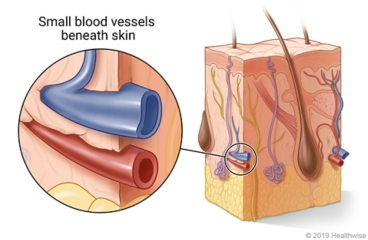
Overview
You can get a bruised nose if you fall or if something hits your nose. The medical term for a bruise is "contusion." Small blood vessels get torn and leak blood under the skin.
Most people think of a bruise as a black-and-blue spot. But bones and muscles can also get bruised. This may damage deep tissues but not cause a bruise you can see.
Your doctor will examine you and will gently press on your nose and face to find areas that are tender. Your doctor will check your eyes, how well you can move the muscles near the bruise, and your feeling around the area to make sure there isn't a more serious injury, such as a broken bone or nerve damage. You may have tests, including X-rays or other imaging tests like a CT scan.
Sometimes it can be hard to tell if a nose is broken or just bruised. The symptoms may be the same. And a broken bone can't always be seen on an X-ray. But the treatment for a bruised nose is often the same as for a broken nose.
A bruised nose may cause pain and swelling of the nose and face. But if there is no other damage, it will usually get better in a few weeks with home treatment.
Follow-up care is a key part of your treatment and safety. Be sure to make and go to all appointments, and call your doctor if you are having problems. It's also a good idea to know your test results and keep a list of the medicines you take.
How can you care for yourself at home?
- Put ice or a cold pack on your nose for 10 to 20 minutes at a time. Put a thin cloth between the ice pack and your skin. Try to do this every 1 to 2 hours for the first 3 days (when you are awake) or until the swelling goes down.
- Sleep with your head slightly raised until the swelling goes down. Prop up your head and shoulders on pillows.
- Ask your doctor when it's okay to return to your normal activities.
- Be safe with medicines. Read and follow all instructions on the label.
- If the doctor gave you a prescription medicine for pain, take it as prescribed.
- If you are not taking a prescription pain medicine, ask your doctor if you can take an over-the-counter medicine.
When should you call for help?
Call your doctor now or seek immediate medical care if:
- Your pain gets worse.
- You have new or worse swelling.
- You have swelling or a bump on the thin wall (nasal septum) between the nostrils of your nose.
- You have new or worse bleeding.
- The area near the bruise is tingly, weak, or numb.
- You have vision changes.
- You have clear fluid draining from your nose.
Watch closely for changes in your health, and be sure to contact your doctor if:
- You do not get better as expected.
Where can you learn more?
Go to http://www.healthwise.net/patientEd
Enter K609 in the search box to learn more about "Bruised Nose: Care Instructions".
Current as of: July 31, 2024
Author: Ignite Healthwise, LLC Staff
Clinical Review Board
All Ignite Healthwise, LLC education is reviewed by a team that includes physicians, nurses, advanced practitioners, registered dieticians, and other healthcare professionals.

